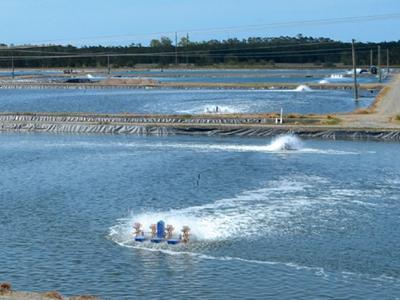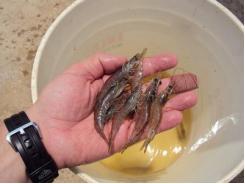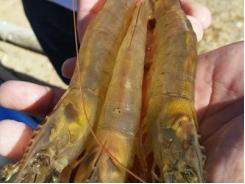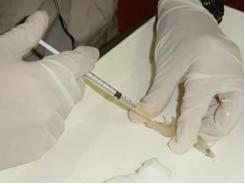Feed tray management lowers FCRs, shrimp production costs in Australia

Black tiger trials with fewer daily feedings show improved conversion results
In lined, aerated ponds, Penaeus monodon fed four times daily had lower FCRs after one month of a culture cycle.
In recent years, shrimp aquaculture costs have increased in every sector. Farmers need to find ways to reduce costs to maintain the profitability of the industry. Currently, one possibility for cost reduction is to manage feed consumption without affecting shrimp growth and total harvest.
Growout production costs for raising black tiger shrimp (Penaeus monodon) in Australia are relatively high compared to those in other countries. Feed, labor, maintenance and power costs all contribute to the situation. Feeding management that lowers feed-conversion ratios can have a direct impact on reducing the costs of production in growout ponds.
Feed conversion
The feed-conversion ratio (FCR) is a measure of shrimp’s efficiency in converting feed mass into increased body mass. FCR is defined as the mass of the food eaten divided by the body mass gain, all over a specified period. For P. monodon, the typical feed-conversion ratio is 1.8.
FCRs are important because higher FCR values indicate uneaten feed that can leach out nutrients in ponds. Leached nutrients impact water quality in growout ponds and potentially increase the nutrient load in the farm effluent. In general, a high FCR means more feed waste and costs, which leads to lower profitability for the farm.
Alternative feed management
In Penaeus monodon growout ponds in Australia, shrimp are usually fed five times daily after they have been in the pond for one month. Shrimp farmers believe that feeding smaller amounts regularly is an effective strategy in maximizing FCR over the entire crop.
An alternative feeding frequency was introduced in the last seven years for Gold Coast Marine Aquaculture’s grow-out ponds. This method involved feeding the shrimp only four times daily. As a result, consistently lower FCRs have been achieved (Table 1).
Shrimp performance achieved with fewer daily feedings.
| Prodution Year (Daily Feedings) | Average Feed - Conversion Ratio | Coefficient of Variation | Average Body Weight (g) | Average Days of Culture |
| 2006-2007 (Five) | 1.71 | 0.17 | 33.23 | 176 |
| 2007-2008 (Five) | 1.64 | 0.18 | 29.94 | 171 |
| 2008-2009 (Four) | 1.42 | 0.10 | 33.49 | 161 |
| 2009-2010 (Four) | 1.43 | 0.05 | 35.83 | 204 |
| 2010-2011 (Four) | 1.45 | 0.23 | 35.09 | 177 |
| 2011-2012 (Four) | 1.49 | 0.20 | 30.19 | 189 |
| 2012-2013 (Four) | 1.42 | 0.14 | 31.64 | 175 |
| 2013-2014 (Four) | 1.47 | 0.06 | 29.64 | 179 |
| 2014-2015 (Four) | 1.43 | 0.07 | 39.50 | 204 |
Based on feed tray information, feed volumes applied at Gold Coast vary across the growout period (Figure 1). Feeding management at involves the following:

Figure 1. Typical daily feed chart of Gold Coast Marine Aquaculture growout ponds.
- Four feeds per day, at 5 a.m., 11 a.m., 5 p.m. and 11 p.m. Feeding is applied using a vehicle with a feed blower, which spreads feed evenly across ponds.
- The three feeding trays used in every pond are employed at the same time the feeding vehicle spreads feed and checked after about three hours. The amount of feed placed on every tray is 0.5 percent of the total individual feeding.
- If no feed is left in the trays, a 3 kg increase in feed volume is made during the next feeding for an average shrimp body weight up to 10 g. An increase of 5 kg is made for shrimp with average body weight greater than 10 g.
- If feed is left on the trays, a 20 to 80 percent decrease is made in the next feeding. Previously, Gold Coast Marine Aquaculture only decreased feeding by 10 to 30 percent when feed was left on the trays. This was due to the belief that a large decrease in feed would lead to a higher rate of cannibalism in P. monodon stocked at high density.
Shrimp do require regular feeding due to their small stomachs and rapid digestion. However, from previous observation, shrimp generally feed and rest periodically before returning to the water column in search of more food.
Benefits
Since the time gap between feedings is a constant six hours, this provides enough time for shrimp to rest before resuming their eating cycle. This allows the shrimp to properly digest their source of nutrients. This simple act can help maximize molt cycle and growth performance.
There is also enough time for pond staff to complete their feeding rounds without needing to rush. This reduces human error when setting and checking feed trays. Monitoring of feed consumption becomes more effective.
Although monitoring of shrimp feed consumption with feed trays has become very important in controlling FCR in intensive operations, this method requires special human attention and an increase in workload for farm staff during production periods, so the trays may sometimes be sidelined or even neglected. Gold Coast Marine Aquaculture reduces this possibility for error by maximizing the time gaps between feeding times.
Shrimp farmers always hesitate to decrease feed volume during shrimp cultivation due to their belief that P. monodon are highly cannibalistic. If the amount of feed is decreased, especially during molting periods, they think, this will cause a decrease in biomass due to cannibalism. Observations made by Gold Coast Marine Aquaculture show the opposite.
Bambang M. Julianto
- Gold Coast Marine Aquaculture Pty. Ltd.
- Marks Road
- Woongoolba, Queensland 4207 Australia
Darrel Herbst
- Gold Coast Marine Aquaculture Pty. Ltd.
Related news
Tools

Phối trộn thức ăn chăn nuôi

Pha dung dịch thủy canh

Định mức cho tôm ăn

Phối trộn phân bón NPK

Xác định tỷ lệ tôm sống

Chuyển đổi đơn vị phân bón

Xác định công suất sục khí

Chuyển đổi đơn vị tôm

Tính diện tích nhà kính

Tính thể tích ao




 PCR methods characterize AHPND V.p isolates
PCR methods characterize AHPND V.p isolates  Measuring susceptibility differences to IHHNV infection
Measuring susceptibility differences to IHHNV infection